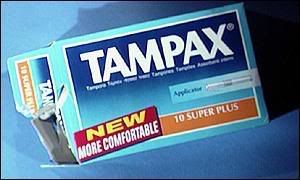Post by The Big PINK One♥ on Feb 4, 2007 15:10:01 GMT -5

This is so serious I had to re-read it to make sure I wasn't infected with this virus since it is some what common with people who wear tampons...
Its a seemingly rare infection called Toxic Shock Syndrome otherwise known as TSS!
Toxic shock syndrome (TSS) is a serious but uncommon bacterial infection. TSS was originally linked to the use of tampons, but it is now also known to be associated with the contraceptive sponge and diaphragm birth control methods. In rare cases, TSS has resulted from wounds or surgery incisions where bacteria have been able to enter the body and cause the infection.
The symptoms of TSS include sudden high fever, a faint feeling, watery diarrhea, headache, and muscle aches. If have these symptoms, it's important to call your doctor right away.
There are steps you can take to prevent TSS. Hand washing can play an important role in guarding against TSS. And if you are just starting your menstrual period, you should understand what precautions you can take to prevent this infection.
What Is Toxic Shock Syndrome?
There are actually two different types of this condition. Toxic shock syndrome, which is caused by Staphylococcus aureus bacteria, has been associated with the use of tampons. (TSS was initially linked to a particular type of tampons, which has since been taken off the market.) Although the exact connection is still not clear, researchers suspect that certain types of high-absorbency tampons provided a moist, warm home where the bacteria could thrive.
Although TSS usually occurs in menstruating women, it can affect anyone who has any type of staph infection, including pneumonia, abscess, skin or wound infection, a blood infection called septicemia, or a bone infection called osteomyelitis.
A related infection, streptococcal toxic shock syndrome, or STSS, is caused by streptococcus bacteria. Most often STSS appears after streptococcus bacteria have invaded areas of injured skin, such as cuts and scrapes, surgical wounds, and even chickenpox blisters. It almost never follows a simple streptococcus throat infection (strep throat).
Symptoms
Toxic shock syndrome
Toxic shock syndrome from staphylococcus starts suddenly with vomiting, high fever (temperature at least 102 degrees Fahrenheit [38.8 degrees Celsius]), a rapid drop in blood pressure (with lightheadedness or fainting), watery diarrhea, headache, sore throat, and muscle aches. Within 24 hours, a sunburn-like rash appears. There also may be bloodshot eyes and an unusual redness under the eyelids or inside the mouth (and vagina in females). After that, broken blood vessels may appear on the skin. Other symptoms may include: confusion or other mental changes; decreased urination; fatigue and weakness; thirst; weak and rapid pulse; pale, cool, moist skin; and rapid breathing.
Prevention
The bacteria that cause toxic shock syndrome can be carried on unwashed hands and prompt an infection anywhere on the body. So hand washing is extremely important.
Females can reduce their risk of TSS by either avoiding tampons or alternating them with sanitary napkins. If a girl uses only tampons, it's important to choose tampons with the lowest absorbency that will handle her menstrual flow and to change the tampons frequently. Between menstrual periods, it's a good idea to store tampons away from heat and moisture (where bacteria can grow) - for example, in a bedroom rather than in a bathroom closet.
Because staphylococcus bacteria are often carried on dirty hands, it's important to wash your hands thoroughly before and after inserting a tampon. If you are just starting your menstrual period, you should know about taking these precautions. Any female who has recovered from TSS should check with her doctor before using tampons again.
Diagnosis & Treatment
Doctors typically treat TSS with antibiotics. If there is a pocket of infection, like an abscess, a doctor also may need to drain the infected area. A person who has TSS is monitored for signs of shock until the condition has stabilized and seems to be improving. Steroids are also sometimes used to treat severe cases of TSS.
Whe To Call Your Doctor
Signs of shock: Go to the emergency department immediately or call an ambulance if you have cold hands and feet; a pulse that is fast and weak; confusion or other mental changes; pale, moist skin; shortness of breath; abnormally fast breathing; or a strong feeling of anxiety or fear.
Signs of TSS: Look for fever; rash (especially a rash that looks like sunburn); nausea and vomiting; watery diarrhea; confusion or other mental changes; and decreased urination. If you use tampons, you should contact a physician or parent immediately if you notice any unusual vaginal discharge, especially if it smells strange or bad. Most of the time that will be due to other causes, but no matter the cause, it still rates evaluation.
For more information on Toxic Shock Syndorme go to ToxicShock.com






